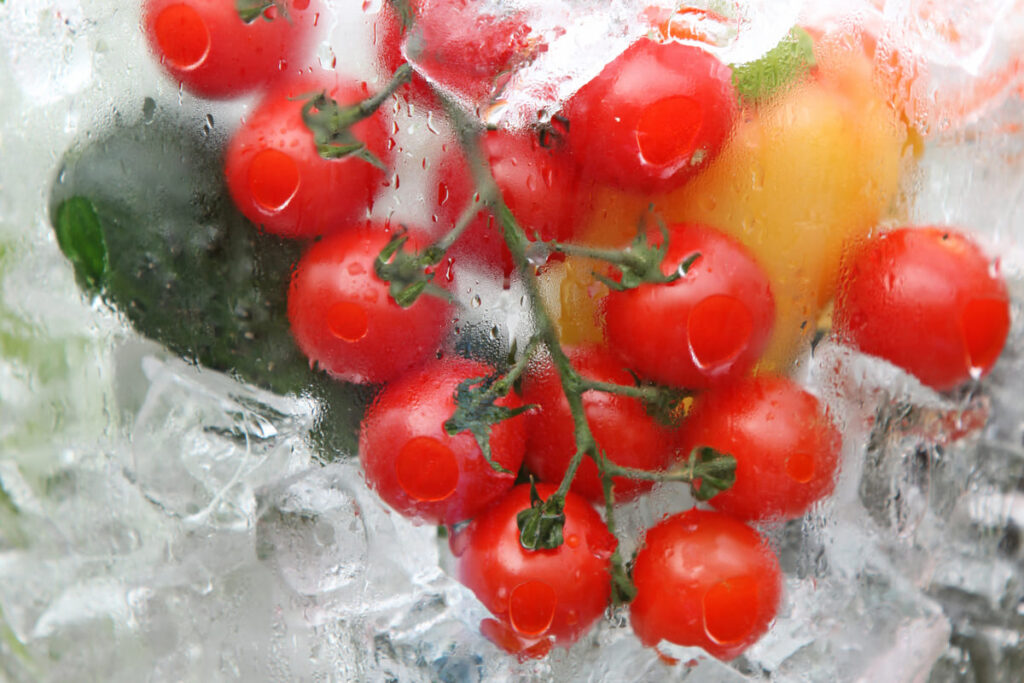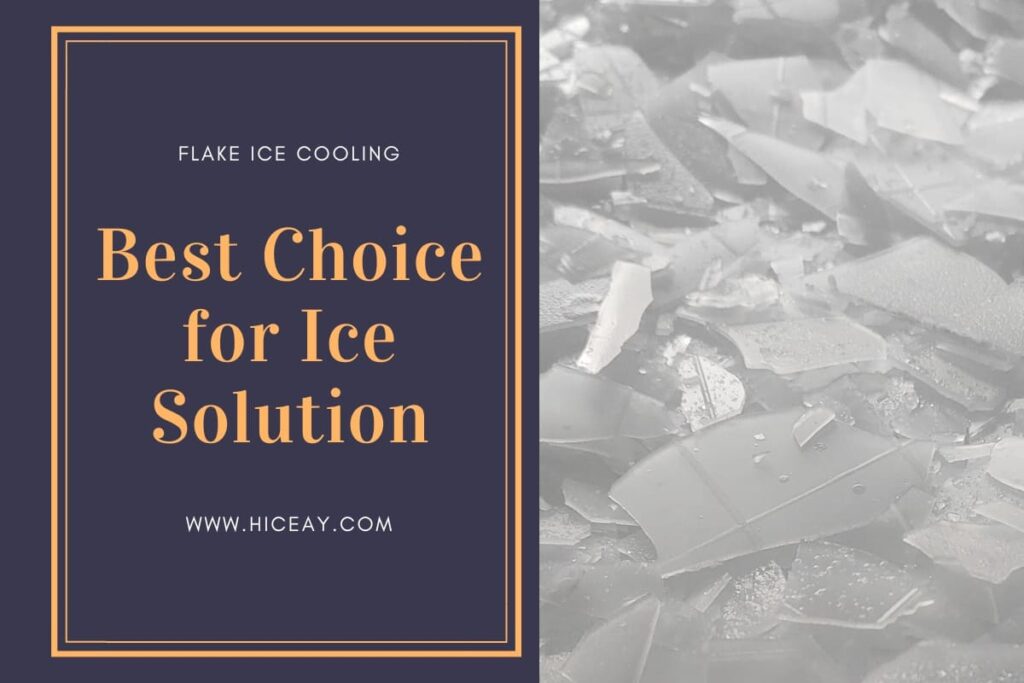How can ice be used to help reduce food waste? As an expert in the field, I am excited to share with you the various applications of ice in preserving perishable food items and subsequently minimizing waste. The use of innovative freezing techniques has revolutionized the way we store and consume foods, ultimately reducing spoilage and conserving valuable resources.
In this blog post, we will explore jelly-based ice cubes for food preservation, different freezing methods such as the air blast freezing technique, contact freezing process, and immersion freezing method that is instrumental in preventing food waste.
Furthermore, we will delve into temperature control in modern food supply chains which play a critical role in maintaining product quality.
Last but not least, our discussion on how can ice be used to help reduce food waste would not be complete without practical tips for home consumers who want to make a difference by implementing proper storage techniques. So join us as we uncover the science behind these processes and learn how each one contributes towards a more sustainable future!

Jelly-Based Ice Cubes for Food Preservation
Envision a realm where cubes of ice don’t thaw, are biodegradable, and have antibacterial characteristics. It appears to be something out of a fantasy flick, no? Well, researchers from the University of California, Davis have turned this dream into reality by developing innovative jelly-based ice cubes that not only prevent cross-contamination in fresh food packaging but also contribute to waste reduction.
Made using 90% water and 10% gelatin hydrogels, these futuristic ice cubes achieve latent heat fusion and cooling efficiency comparable with traditional ice while being reusable around a dozen times before disposal. So how can they be used to help reduce food waste?
Applications in Fish Processing Plants to Reduce Pathogen Spread
Fish processing plants are always on the lookout for ways to maintain freshness and hygiene standards. The introduction of these jelly-based ice cubes could revolutionize their operations by reducing pathogen spread among seafood products.
By incorporating antimicrobial properties within the gelatin hydrogel matrix itself (as opposed to relying solely upon external sanitization measures), fishery operators can ensure that their product remains free from harmful bacteria throughout its journey along supply chains – ultimately leading to fewer instances of spoilage-related wastage occurring overall.
Reusable Nature Contributes to Waste Reduction
- Eco-friendly: Traditional single-use plastic bags filled with crushed or cubed conventional frozen H2O often end up discarded after just one use; however, thanks to the biodegradable materials employed during the manufacturing process, these new jelly-based ice cubes last considerably longer (around twelve cycles) making them a far more environmentally friendly choice in the long term.
- Cost-effective: By reusing these jelly-based ice cubes multiple times before disposal, businesses can save on costs associated with purchasing and disposing of traditional ice. This not only helps reduce their operational expenses but also contributes to a more sustainable food industry.
In conclusion, the innovative jelly-based ice cubes developed by UC Davis researchers hold great potential for reducing food waste in various industries such as fish processing plants and seafood distributors.
Their antimicrobial properties help maintain freshness while preventing cross-contamination among products. Thanks to the biodegradable materials employed during the manufacturing process, these new jelly-based ice cubes last considerably longer (around twelve cycles) making them a far more environmentally friendly choice in the long term.
Jelly-based ice cubes are an effective way to reduce food waste and maintain the quality of products in fish processing plants. By utilizing different freezing methods, it is possible to further improve efficiency while reducing wastage.
Researchers from the University of California, Davis have developed jelly-based ice cubes with antimicrobial properties that prevent cross-contamination in fresh food packaging and contribute to waste reduction. These eco-friendly and cost-effective ice cubes can be reused around a dozen times before disposal, making them a more sustainable choice for businesses such as fish processing plants.
Freezing Methods to Reduce Food Waste
When it comes to reducing food waste, freezing is the superhero we all need. Freezing offers a range of methods to preserve food without sacrificing either nutrition or flavor, making it an ideal tool for reducing waste. Let’s dive into three main freezing techniques and how they can help save the day (and our precious grub).
Air Blast Freezing Technique
Air blast freezing is like giving your food a chilly hug from Mother Nature herself. This method involves placing the product on trays or racks inside a freezer with powerful fans that circulate cold air at high speeds around them. The rapid temperature drop ensures quick and even freezing while maintaining quality and texture.
Contact Freezing Process
If you’ve ever wished for an instant freeze button for your perishables, contact freezing might be as close as you’ll get. In this process, food items are placed in direct contact with refrigerated surfaces such as plates or belts which rapidly absorb heat from them. It’s perfect for thin products like fish fillets or sliced fruits where speed is crucial in preserving freshness.
Immersion Freezing Method
Last but not least, let us introduce you to immersion freezing, the ultimate ice bath experience for your edibles. Products are submerged in a cold liquid, usually brine or an antifreeze solution, which quickly freezes them while forming a protective ice layer. This method is ideal for irregularly shaped items like shrimp and berries but requires regular thorough cleaning to prevent contamination.
It’s time to take action and battle food waste with these freezing techniques. Remember:
- Air blast freezing is perfect for quick and even temperature drops
- Contact freezing works best on thin products requiring rapid cooling
- Immersion freezing suits irregularly shaped items but needs extra care in the cleanliness
No matter what method is employed, the end result will be rewarding – both for your food and the environment.
By utilizing freezing methods such as air blast, contact, and immersion freezing processes, food waste can be significantly reduced. Temperature control in modern food supply chains is essential to maintain constant cold temperatures throughout the entire process.
Freezing is a superhero in reducing food waste and preserving foods without compromising their nutritional value or taste. Air blast freezing, contact freezing, and immersion freezing are three main techniques that cater to different types of products. Each method has its own benefits and can be used depending on the type of product being frozen.
Temperature Control in Modern Food Supply Chains
When it comes to preserving food and reducing waste, temperature control is the unsung hero of modern food supply chains. Maintaining constant cold temperatures throughout every stage of transportation – from production facilities right up until they reach consumers’ hands – is crucially important for keeping our favorite foods fresh and delicious.
Importance of Maintaining Constant Cold Temperatures
The key to preventing spoilage and ensuring optimal quality lies in maintaining consistently low temperatures. Keeping cold temperatures helps preserve taste, texture, and nutrition for the products we enjoy.
It’s no wonder that temperature-controlled environments are a must-have for any business involved in transporting perishable goods like fruits, vegetables, meats, dairy products, or even those delightful ice cream treats.
- Air Blast Freezing Technique: In this method, chilled air circulates around the product at high speeds resulting in rapid freezing. The process ensures minimal damage to cell structures within the food items while preserving their freshness.
- Contact Freezing Process: Herein direct contact between metal plates or belts with frozen coolant inside facilitates quick cooling rates without causing significant dehydration loss during storage periods afterward.
- Immersion Freezing Method: This involves dipping products into liquid refrigerants such as brine solutions which have lower melting points compared to traditional water-based alternatives thus allowing faster heat transfer times overall when used alongside other techniques mentioned above (although regular thorough cleaning becomes necessary due to susceptibility to contamination).
Smart Systems for Monitoring Cooling Units
In today’s quick-paced universe, innovation is assuming a noteworthy job in guaranteeing our sustenance stays unadulterated and new. Enter smart systems for monitoring cooling units. These advanced solutions can identify malfunctioning cooling equipment and promptly alert maintenance teams responsible for keeping the conditions just right during transit.
Envision a situation where perishable items are in transit and their refrigeration system is malfunctioning – this would be quickly identified by smart systems, allowing for immediate action to prevent spoilage and save resources.
With smart systems in place, alerts would be sent out immediately so that appropriate action can be taken before any damage occurs – saving both time and money while reducing potential waste caused by spoiled products.
No longer do we have to rely on guesswork or manual checks; these innovative technologies provide real-time data allowing us to ensure optimal conditions at all times within modern food supply chains – ultimately helping reduce global waste levels one degree at a time.
Temperature control in modern food supply chains is a critical factor to consider when it comes to reducing waste levels and preserving resources. By utilizing advanced freezing techniques, such as those offered by Hiceay ice machines, the global community can significantly reduce its overall level of food waste.
Maintaining constant cold temperatures throughout every stage of transportation is crucially important for keeping perishable foods fresh and delicious, ultimately reducing food waste. Innovative technologies such as smart systems for monitoring cooling units can identify malfunctioning equipment and promptly alert maintenance teams to take appropriate action before any damage occurs, saving time and money while helping reduce global waste levels one degree at a time.
The Role of Frozen Foods in Reducing Global Waste Levels
Have you pondered how much grub is discarded annually? According to the United Nations Environment Programme, an estimated 17% of global food production is being lost due to waste each year; however, Darcy Simonis suggests that frozen foods may provide a solution.
But fear not, dear reader. Darcy Simonis, an industry expert, believes that frozen foods hold the answer to reducing these staggering levels of discarded produce.
Preserving Resources Efficiently via Advanced Freezing Techniques
Frozen foods allow us access to preserved ingredients whenever we need them most rather than relying solely upon fresh options available only when harvested locally according to seasonal cycles alone (which inevitably leads to increased spoilage rates).
By utilizing advanced freezing techniques like air blast freezing and contact freezing, we can maintain the nutritional value and taste of our favorite fruits and veggies all year round. This means less waste as well as a more diverse diet for consumers worldwide.

Minimizing Waste by Checking Expiration Dates Regularly
A crucial aspect of reducing food waste is being mindful of expiration dates on both fresh and frozen products. Make it a habit to check your freezer regularly for items nearing their “best before” date – after all, even frozen goods have a shelf life.
To make this process easier, consider organizing your freezer with labels or containers indicating when items were first stored. And remember: just because something has passed its expiration date doesn’t necessarily mean it’s unsafe; use your senses (smell, sight) combined with good judgment before tossing anything out.
Besides playing our part at home by checking expiration dates and properly storing our groceries (here’s a handy guide), we can also support businesses that prioritize sustainability and waste reduction.
For example, Hiceay, the leading manufacturer of premium quality ice machines such as commercial and industrial flake ice machines and tube ice machines, plays an essential role in maintaining optimal temperature control throughout food supply chains.
So next time you’re at the grocery store debating between fresh or frozen produce, remember: choosing frozen options not only offers convenience but also contributes to reducing global food waste levels. Let’s all do our part in preserving resources efficiently while enjoying delicious meals.
Frozen foods are an effective way to reduce global waste levels, and with the right techniques, they can be stored safely for long periods of time. Practical tips such as preparing herbs for freezing or treating fruits with acids before storage will help ensure that food items are kept at appropriately low temperatures in order to maximize their shelf life.
Frozen foods can help reduce global food waste levels, according to industry expert Darcy Simonis. Advanced freezing techniques such as air blast and contact freezing preserve the nutritional value and taste of fruits and vegetables all year round, leading to less waste and a more diverse diet for consumers worldwide. Checking expiration dates regularly is also crucial in minimizing waste, while supporting businesses that prioritize sustainability like Hiceay plays an essential role in maintaining optimal temperature control throughout food supply chains.
Practical Tips for Freezing Foods at Home
Aiming to minimize food waste, freezing foods can be an effective approach. To ensure that your favorite ingredients remain as delicious and nutritious as possible, proper freezing techniques should be utilized. Here are some practical tips that will help you master the art of freezing:
Preparing Herbs for Freezing
Fresh herbs add a burst of flavor to any dish but tend to spoil quickly if not used in time. To extend their shelf life, simply wash them on stems under cool water before steaming them briefly or freezing them directly. This method retains its vibrant color and aroma while keeping bacteria at bay.

Treating Fruits with Acids Before Storage
Fruits are prone to browning when exposed to air during storage, which affects both appearance and taste. To preserve the quality of fruits, adding ascorbic acid (vitamin C), citric acid (from citrus fruits), or lemon juice before storage can slow down oxidation and browning. These acids act as antioxidants that slow down oxidation processes responsible for browning.
Storing Various Food Items at Appropriate Low Temperatures
- Baked goods: Freeze leftover bread, muffins, cakes, and cookies by wrapping them tightly in plastic wrap followed by aluminum foil before storing them inside airtight containers or resealable bags.
- Cured meats: Salami and other cured meats last longer when stored below 0°F (-18°C) – just make sure they’re well-wrapped.
- Dairy products: Butter, cheese, and milk can all be frozen successfully. For best results, cut large blocks of cheese into smaller portions before freezing.
- Eggs: Whole eggs can be cracked into a bowl and whisked together before being poured into ice cube trays for easy portioning later on. However, it’s important to note that thawed eggs should only be used in cooked dishes due to potential bacterial growth during defrosting processes.
Incorporating these simple tips into your food storage routine will not only help you reduce waste but also save money by making the most out of every ingredient you purchase. So go ahead – embrace the power of freezing.
Freezing foods can help reduce food waste, and with the right techniques, you can preserve ingredients without compromising their taste or nutritional value. Tips include preparing herbs for freezing by washing them on stems under cool water before steaming them briefly or freezing them directly, treating fruits with acids to prevent browning during storage, and storing various food items at appropriate low temperatures such as baked goods wrapped tightly in plastic wrap followed by aluminum foil before storing inside airtight containers or resealable bags.
FAQs in Relation to How Can Ice Be Used to Help Reduce Food Waste?
How Can We Reduce Food Waste by Freezing?
Reducing food waste through freezing involves proper storage techniques, such as using air blast, contact, or immersion freezing methods. Additionally, maintaining constant cold temperatures and monitoring cooling units with smart systems helps preserve resources efficiently. Preparing herbs for freezing and treating fruits with acids before storage also contributes to minimizing waste.
How Can Food Waste Be Reduced?
To reduce food waste, practice efficient meal planning and shopping habits while regularly checking expiration dates on products. Utilize appropriate preservation methods like refrigeration or freezing. Donate excess perishable items to local charities or compost organic materials at home to minimize the environmental impact of wasted food.
What Is the Best Way to Reduce Food Waste?
The most effective approach to reducing food waste combines mindful consumption practices with innovative technologies like jelly-based ice cubes, advanced freezing techniques, and temperature control systems in modern supply chains. These strategies help maintain product quality throughout distribution processes while encouraging responsible consumer behavior at home.
Conclusion
In conclusion, ice can be used in various ways to help reduce food waste. Jelly-based ice cubes can preserve fish and seafood by reducing the spread of pathogens in processing plants. Freezing techniques such as air blast freezing, contact freezing, and immersion freezing can also minimize waste by extending the shelf life of food products. Temperature control is crucial in modern food supply chains, with smart systems available for monitoring cooling units.
Frozen foods play a significant role in reducing global waste levels through advanced preservation methods that efficiently conserve resources. Practical tips for freezing foods at home include preparing herbs for storage, treating fruits with acids before storing them, and ensuring that different types of food are stored at appropriately low temperatures.
Overall, using ice to reduce food waste is an effective strategy that benefits both businesses and individuals alike. For more information on how you can contribute to this effort while enjoying high-quality products every time you shop or cook, visit HICEAY.


